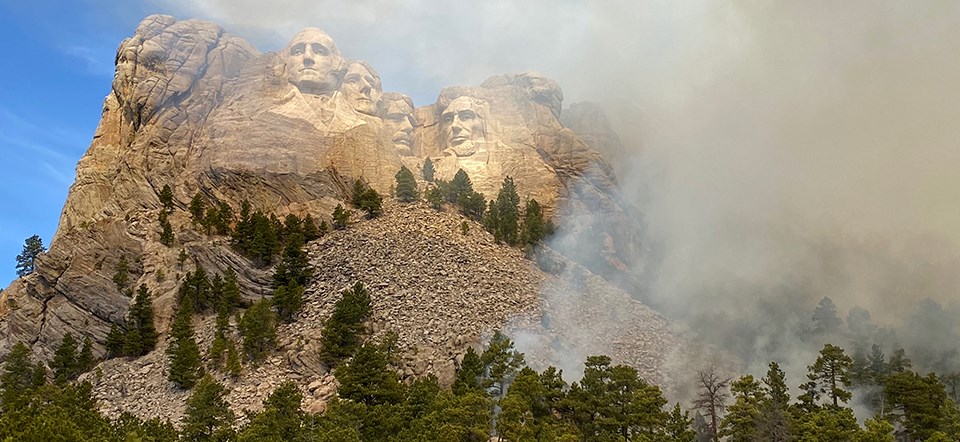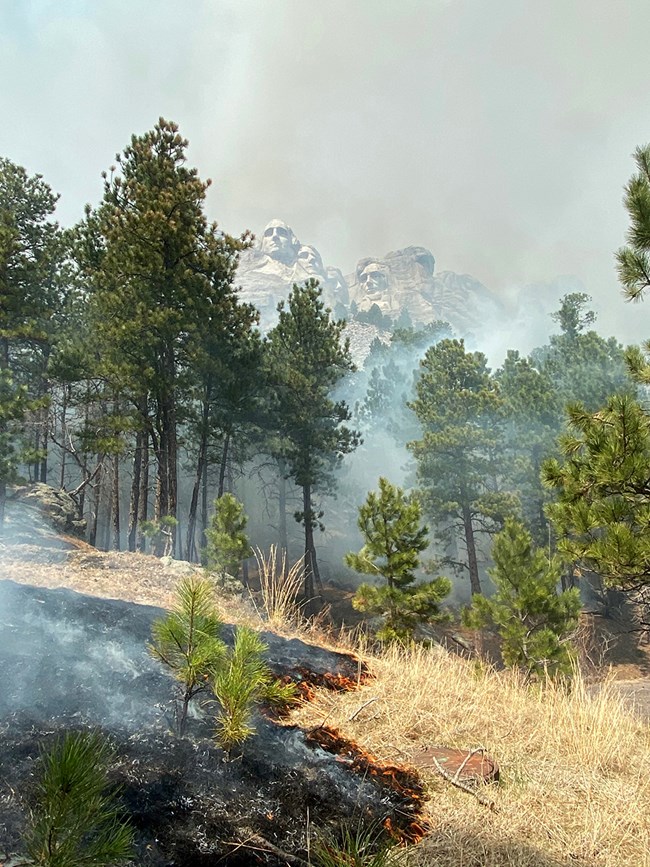Last updated: January 19, 2021
Article
Large-Scale Prescribed Fire Returns to Mount Rushmore National Memorial

NPS/JM JOHNSON

NPS/JM JOHNSON
The ponderosa pine forests within and surrounding the Memorial has suffered from years of impact from storms and infestations from mountain pine beetles (Dendroctonus ponderosae). MORU has successfully completed several fuel-reducing projects in the past, to prevent or slow the growth of wildfires. In 2010, MORU began a fuels reduction project to reduce the amount of dead timber, thin younger trees (less than 6” diameter) that served as ladder fuels, and eventually decrease the potential for high severity fires. In the years since that thinning project, fire staff from the Northern Great Plains Zone Fire Management Office began reducing the piles of debris that were scattered throughout the forest. Those piles were typically burned in winter or spring when the snowpack prevents the fires from moving around. This broadcast burn allowed the Memorial to reduce fuels across a larger area and was conducted under approved prescription conditions.
Fifty-four firefighters gathered on the morning of the burn and using newly developed firefighter protocols relating to Covid-19, had their temperatures taken and were given assignments and briefings in small groups, rather than a typical large briefing. Agencies that assisted with the burn included: NPS (Northern Great Plains Fire Management, Black Hills Wildland Fire Module, MORU, Badlands National Park, Theodore Roosevelt National Park, Indiana Dunes National Park, Midwest Regional Office (DOI Regions 3, 4, & 5), Ozark National Scenic Riverways, Buffalo National River, Buffalo Wildland Fire Module). Interagency assistance was provided by Ellsworth Air Force Base, South Dakota Wildland Fire Division (SD Department of Agriculture), US Fish and Wildlife Service, and local fire departments.
After a successful test fire conducted high on the ridge to the east of the sculpture, firefighters utilized hand ignition to set backing fires and flanking fires. Firing techniques were closely managed to reduce the amount of risk to personnel and structures and minimize smoke impacts to nearby communities and Highway 244.
MORU consists of 1,278 acres of land, and these 251 acres were located in the most heavily developed portion. It included the historic Sculptor’s Studio, the amphitheater, visitor center, administrative offices, parking garage, water treatment facilities, and employee housing areas. The timing was perfect to reduce impacts to staff and visitors. Visitation was reduced following stay-at-home orders for Covid-19. The Avenue of Flags, amphitheater, visitor center, and Presidential Trail were closed for construction and seasonal staff had not yet moved into employee housing. The success of the day was capped when initial observations showed that fuels reduction objective was met.
